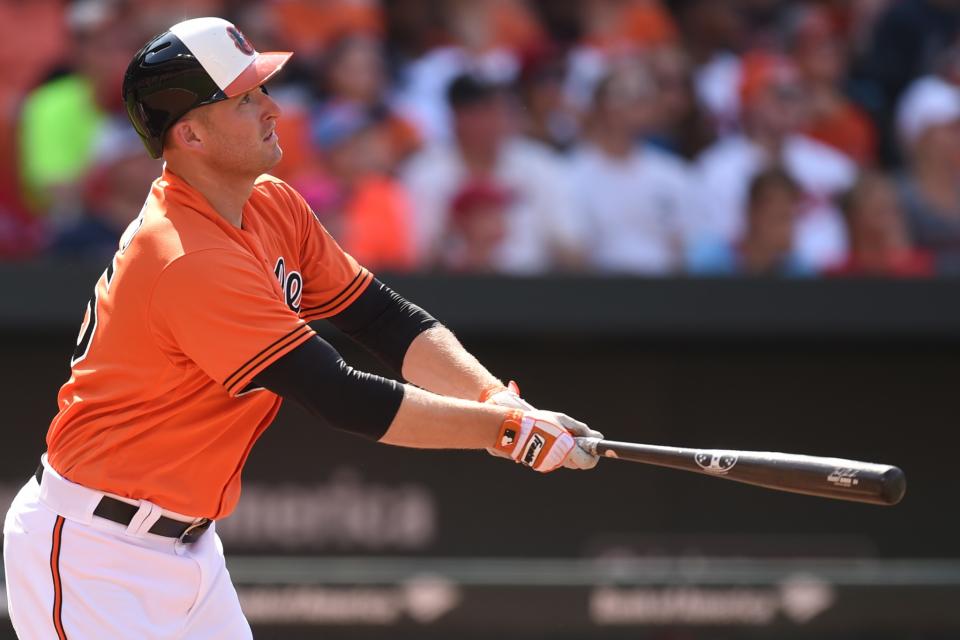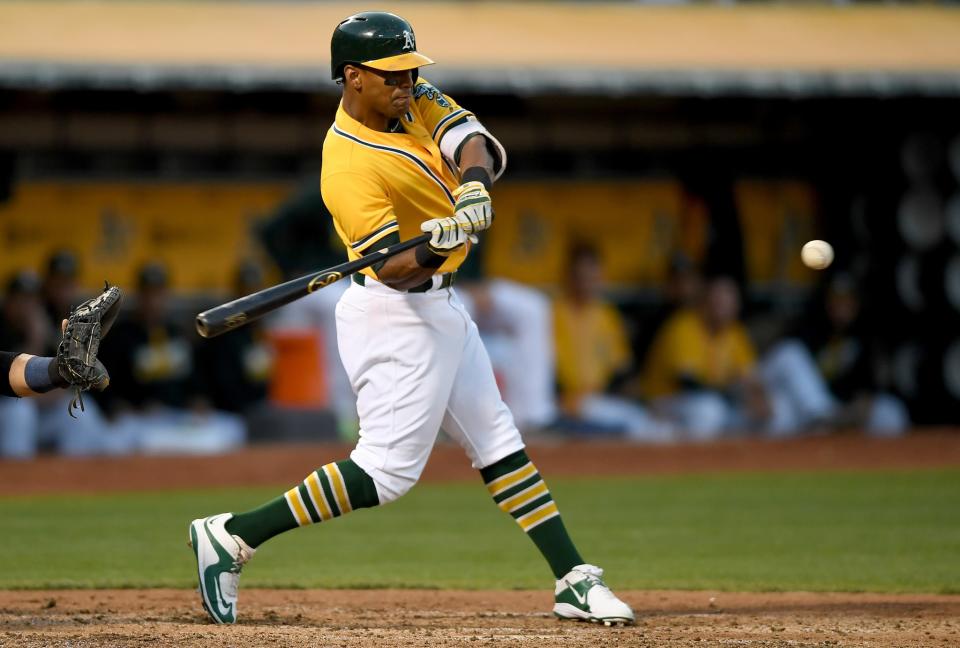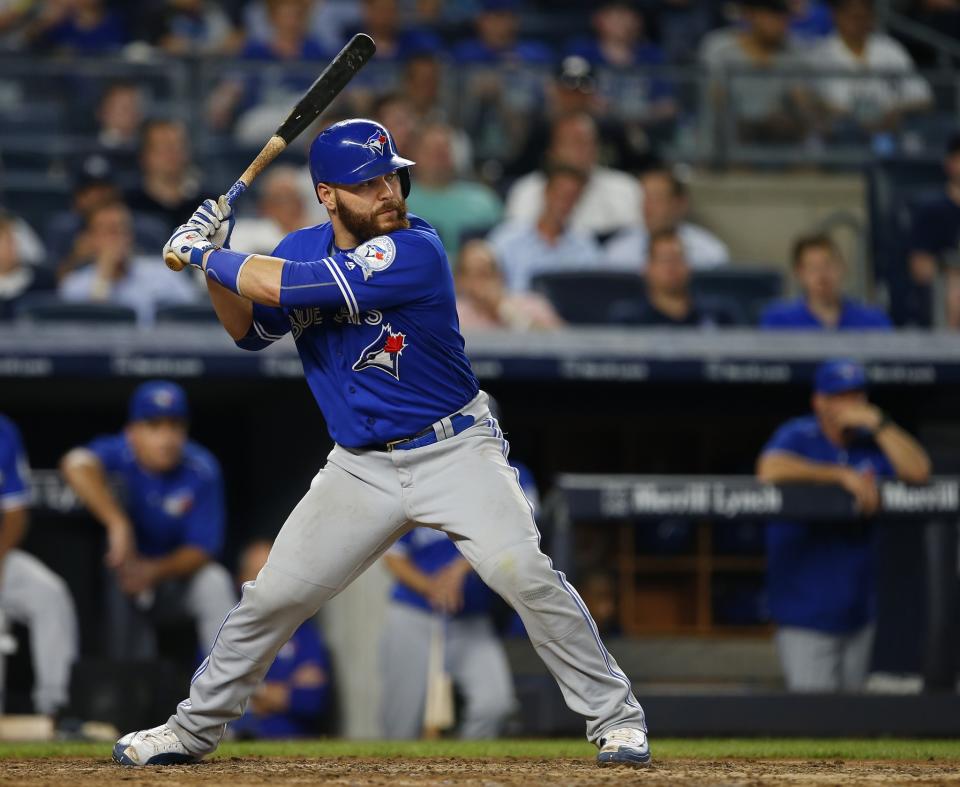Why 2016 is the Year of the Home Run

The Year of the Home Run is almost over, and nobody seems to realize it’s the Year of the Home Run. It’s been furtive like that. Barring a final-week onslaught, the major league leader won’t reach 50. Only six players have 40, and just one is a star, and calling him that may be a stretch. Which is what has made this so sneaky. Baseball is living the dream of every politician: enriching the middle class.
Before explaining how, take a look at the raw numbers first, because they are that staggering. Absent a home run collapse in the final week, major leaguers in 2016 are going to have finished their plate appearances with a home run rate higher than any season in baseball history. The heart of the steroid era? They homered less often. The bonanza 1987 season? Nope. How about 1961, with Maris and Mantle? Not even close. In 176,371 plate appearances this season coming into Sunday, major league hitters had homered 5,392 times, or 3.06 percent of their plate appearances. Never before have they cracked the 3 percent mark.
Hitters likely won’t reach the single-season record of 5,693 home runs, set in 2000, because the run-scoring environment 16 years ago led to about 5,000 more plate appearances. Still, 2016 occupies fifth place in single-season home runs, and it’s a good bet to leap into second all-time, passing 1999 and its 5,528.
It’s certainly not because of the league leaders. Nor is it an unparalleled bevy of 30-homer sluggers. There are barely two-thirds as many of those as there were in 2000. Mostly, it’s an onslaught of guys who aren’t home run hitters turning into home run hitters. On Sunday, Jung-ho Kang became the 103rd player to hit at least 20 home runs this season (in 297 at-bats), tying the record from 2000. It will be smashed this week. The record for 10-plus-homer hitters should fall, too.
No obvious explanation exists for how the homer rate jumped from 2.28 percent of plate appearances two years ago to the 3.06 percent today. Some have theorized juiced balls. Others have suggested an influx of undetectable performance-enhancing drugs. And the question of approach remains palpable: With an almost-inconceivable 8.02 hitters striking out every nine innings, the desire to sell out for home runs is ever greater.
Whatever the case, home runs have turned the great offensive drought of 2013, ’14 and most of ’15 – at least until the end, when the homers started flying – into something of an afterthought. Runs aren’t being scored at the rate of 2000 – a hilarious 5.14 per game – but the 4.48 per this year is respectable enough to have silenced some of the thoughts about how to juice scoring. Some of those ideas, like recalibrating the strike zone, do have merit. Others may fall by the wayside because of the home run revolution.
Years from now, perhaps we’ll better understand the spike that saw Hernan Perez, he of one home run in 351 career plate appearances entering the season, whack 13 in 400 times at the plate. And Jose Altuve turn into Hack Wilson, a 5-foot-6 home run hitter, with more this season than his first four combined. And Brad Miller become the 30-homer club’s least recognizable member. (Saved you a click: He’s the Tampa Bay Rays’ shortstop, and he came into this season with 29 homers in well over 1,000 plate appearances.)
And lest we forget the major league leader in home runs …
1. Mark Trumbo, a man with a trade market so grim during the offseason the best the Seattle Mariners could get for him was Steve Clevenger and two racist tweets to be named later.
Now Trumbo is a week away from his first home run crown, a monumental upset seeing as he didn’t even hit half as many last season and one-dimensional sluggers in Trumbo’s mold often crater upon their 30th birthday. Trumbo turned 30 in January, about a month after the Mariners dealt him to the Orioles because they feared the size of his arbitration salary. He wound up at $9.15 million, a cut rate for a prolific power bat.
And yet the truth about Trumbo is one of quite a few sluggers today: That one-dimensionality somewhat limits his value, as measured by the metrics by which teams abide. During the power drought of recent seasons, home runs were a rare commodity for which teams gladly paid extra. So long as balls are flying at their current rate, and even middle infielders can go upper tank on the regular, the premium lessens, and things like Trumbo’s .312 on-base percentage and gruesome glove stand out.
Does that make him worse than Jose Iglesias, Danny Espinosa and a pair of Chases, Headley and Utley? In reality, probably not, though every version of Wins Above Replacement rates those four, among plenty more lesser hitters, more valuable than Trumbo. Without completely casting aspersions on fielding and baserunning, it feels like Trumbo should be worth more based on a slugging percentage at least 130 points greater than those four, but then again, feelings in baseball can be overrated and dubious. Few, after all, felt …
2. Khris Davis was much more than a bootleg version of his more commonly named baseball doppelganger. Like Chris, he didn’t get everyday major league at-bats until his 26th birthday. Like Chris, he mixed flashes of great power with frustrating patience. Unlike Chris, once he showed potential, he didn’t get a full opportunity to show what he could do over 600 plate appearances.

Davis’ trade to Oakland this offseason afforded him that, and he may be the unlikeliest member of the 40-homer Class of 2016. The rest of Davis’ game leaves plenty to be desired. He’s an average-at-best left fielder. He’s not a particularly deft baserunner. He doesn’t hit for average. He strikes out too much. Those home runs, though – they’re delightful and glorious for an A’s team whose last 40-home run hitter was Jason Giambi in 2000.
The question, now, is whether Davis takes the Trumbo path. He is arbitration-eligible for the first time this winter, and home run hitters get paid well in the system. Oakland almost certainly will hold onto Davis for next season, when he’s 29, but if he repeats his 2016, questions of cost may come into play. Unless, of course, they do what the Minnesota Twins did with …
3. Brian Dozier and try to lock him up to a below-market deal. This is unlikely with Davis, seeing as his breakout arrived. Dozier’s deal for four years and $20 million bought out his last pre-arbitration season and his three arb years – and with two seasons left, it is paying off rather handsomely.
With 28 home runs and an All-Star appearance last season, Dozier would have received well over his $3 million salary had he gone year to year in arbitration. And the bargain the Twins get next season at $6 million and the year after at $9 million are big enough that their new president, whoever it may be, would be smart to consider trading Dozier coming off his 2016.
Of Dozier’s 42 home runs, 40 have come with him at second base. It’s a big number for any position and otherworldly for a second baseman, with two-thirds of the home runs coming in the second half, during which Dozier has a slugging percentage near .700, he’s going to be on a lot of MVP ballots, even with the Twins’ dreadful season. Dozier showing up on an MVP list without even making the All-Star team is like …
4. Gary Sanchez winning American League Rookie of the Year after spending the first four months of the season in the minor leagues. Welcome to the conundrum of Rookie of the Year voters, who must decide between a player off to a transcendent start of his career or the AL earned-run average leader.
On one hand, Sanchez is pretty amazing. He became the fastest player in history to 19 home runs, and he could help 2016 break 2000’s record for 20-homer players with his next one. Sanchez is hitting .322/.397/.706 over his 180 at-bats. It’s about as good of a two months as one could have, and it’s coming from a 23-year-old catcher.
Then there’s Michael Fulmer. He didn’t arrive until the end of April, though once he did, the Detroit Tigers became contenders. Fulmer has thrown 155 2/3 innings of 2.95 ERA ball this season. He’s the only starter in the AL with an ERA that starts with a 2. He’s got a great groundball rate, doesn’t walk anyone, isn’t excessively home run prone and strikes out enough hitters. The argument, really, boils down to five months of well-above average vs. two months of undeniably great – and of pitcher, commonly snubbed in Rookie of the Year voting, vs. hitter.
One battle Sanchez loses, upon his next home run, is most implausible 20-homer guy. Because nobody ever would’ve guessed …
5. Freddy Galvis was going to do it, even with a full six months in the big leagues. He may well be the poster boy of the 2016 spike. Galvis is, by almost every measure, a terrible hitter. Coming into this season, his career slash line was .241/.282/.352 over 1,153 plate appearances. He had exactly 20 home runs.
So what to make of this year, in which the glove-first shortstop has 20 in a little more than 600 plate appearances? The average exit velocity on his balls in play has jumped 2 mph, and that certainly accounts for some of it. The average launch angle on his hard-hit balls is slightly higher. Still, 20 career home runs, 20 home runs this season.
At least with Christian Yelich, who has the exact same 20-20 vision, there was the promise of more home runs as he grew older because of his gorgeous swing and body type. Galvis was always the sort who figured to max out around 10 homers – and maybe, as time goes on, that will be him. For now, he and …
6. Russell Martin are this year’s big 20-homer riddles, though for different reasons. While Martin whacked a career-high 23 home runs last season with Toronto, he was so bad for the first quarter of the season, so feckless with his bat, 20 seemed like a pipe dream. Even 10 was a stretch.

In the Blue Jays’ first 47 games this year, Martin hit .172/.243/.180. He had one extra-base hit and 45 strikeouts in 122 at-bats. He was the worst hitter in baseball. Then neck cramps that had hindered his swing abated, and Martin’s power returned with a pair of home runs May 25. In his 90 games including that one, Martin is hitting .265/.374/.510 with 20 home runs.
It goes to show: Even someone who’s lost as June dawns can still turn a nothing season into something productive. Just ask …
7. Kendrys Morales, who wasn’t quite as bad as Martin but was hitting .191/.257/.320 on June 6. Since then, Morales has hit .305/.370/.559 with 24 homers in 94 games. He’s got 30 on the season. The last time he hit more than 30 was before the awful knee injury he suffered in a walk-off celebration at home plate.
Even if Morales doesn’t break Steve Balboni’s seemingly untouchable record for home runs by a Kansas City Royal – his 36-homer season has held for more than 30 years – he does provide one of the more fascinating offseasons of 2016-17. The qualifying offer this offseason is estimated around $16.7 million. For a designated hitter today, that’s big money. Amazing fact: Never has David Ortiz made more than $16 million in a season.
Still, Kansas City almost certainly will offer it to Morales. The downside of a one-year contract is minimal, and with Morales having been stuck in qualifying-offer limbo before, he may well take it, knowing the market for 33-year-old DHs isn’t particularly robust. By WAR’s measure, Morales isn’t worth the offer, though we know productivity is in the eye of the beholder – or the algorithm – and, like Morales …
8. Matt Kemp’s value depends almost exclusively on one’s view of offense vs. baserunning and defense. Kemp’s bat has been more than tolerable, even to those who blanch at his .304 on-base percentage. He has 33 home runs, the most since his coulda-been MVP season in 2011. He’s walking more (18 in 50 games) since his trade to Atlanta. Kemp is still rather unsightly in a uniform, and the comments Braves GM John Coppolella made about Kemp needing to lose weight were on point, because on an NL team, the other facets of his game can’t be hidden behind his stick alone.
Three more seasons remain on Kemp’s eight-year, $160 million contract, and the Braves are on the hook for a little more than $15 million in each of them. Considering they offloaded the dead money of Hector Olivera’s deal, it feels like less to Atlanta, and if Kemp can be what he’s been this season, they’ll be elated. He’s 32 now, past his time as an all-around player, never again showing the two-way supremacy …
9. Nolan Arenado embodies about as well as anyone. He was the maybe-superstar referenced earlier, and if he’s not, it’s only because he plays for the Colorado Rockies, and the populace tends to discount the numbers of Rockies players because of Coors Field and the team’s general mediocrity.
Well, Arenado is price-of-admission good. For the second consecutive season, he’s slated to lead the NL in home runs and RBIs. He is going to walk twice as much as he did last season. And his glove at third base is in the conversation for the best in the game, which is saying something considering the plethora of great third basemen today. Between that group (NL MVP-to-be Kris Bryant, Josh Donaldson, Manny Machado and plenty more) and the return of the power-hitting shortstop (in addition to Galvis, 14 other shortstops have at least 15 homers, and Francisco Lindor could join them this week), the left sides of infields have fueled the 2016 power surge.
Amid the all-around games survives that never-dying breed, the classic masher whose sole purpose seems to be hitting home runs. And we salute you …
10. Mark Trumbo, for being that hero. Daniel Murphy has evolved into a power hitter? Well, good for him. Mike Napoli and Carlos Santana have 34 each? Whooptie-damn-doo. Jay Bruce reached 30 home runs? All of New York wants to bench him still.
Trumbo just keeps mashing taters. And he does so with free agency beckoning this offseason. Trumbo’s market will be even more fascinating. After his AL-leading 40-homer season two years ago, Nelson Cruz signed a four-year, $57 million deal with the Seattle Mariners. He followed up last year with 44 home runs and hit his 40th and 41st homers this season Sunday. He has been one of the most potent bats in baseball two years’ running.
For now, Trumbo isn’t seen in the same echelon as Cruz, though in hindsight, Cruz’s deal was a distinct bargain for Seattle. Trumbo will have a qualifying offer attached to him, which could hinder him slightly, and NL teams will fear playing him in the outfield, which may limit him even more. Then again, 45 home runs, or however many Trumbo ends up with, solves a lot of problems and prompts teams to overlook plenty of weaknesses.
Even in the Year of the Home Run, it’s an impressive tally, suitable for the season where the ball flew out of the park just a little more often. Quietly and stealthily so, but unquestionably more.


